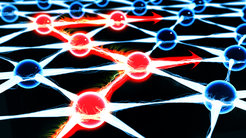Ultrafast Polymers
Energy Superdiffusion via Excitons
Researchers at the Max Planck Institute for Polymer Research discover ultrafast, long-range and low-loss energy transport in organic semiconductors — with potential applications in light-harvesting, biotechnology, and nano-medicine.

An international research team including Dr. Yuping Shi and Prof. Dr. Katharina Landfester from the Max Planck Institute for Polymer Research in Mainz has achieved a significant breakthrough in the field of organic semiconductors. For the first time, researchers observed a phenomenon known as “superdiffusion of excitons”.
Excitons are energetic quasiparticles generated when an organic material absorbs light. They migrate through the molecular network and can, for example, produce electric current in a solar cell or trigger sensing signals in a cell-like environment. The farther and faster they move, the more efficient the material becomes.This exciton superdiffusion was observed in solid deposits of polymer semiconductors— indicating extremely fast and long-range movement of photoexcitons with minimal energy loss.
“This insight brings us a major step closer to developing organic materials capable of transporting light energy as efficiently as native photosynthetic protein complexes and inorganic semiconductors — but at significantly lower production costs and with greater flexibility in a wide range of conventional and emerging semiconductor technologies,” says Dr. Shi.
The researchers from MPI-P, UC Berkeley, and Princeton University studied especially red-shifted copolymers that absorb and respond strongly to deep-red to near-infrared light — a highly desirable property made possible by extended, planar polymer backbones. Using advanced phase-cycling pump-probe spectroscopy for quantitatively separating otherwise coupled single-, two-, and three-particle nonlinear responses, they were able to identify, for the first time, a diffusion constant of over 0.5 cm²/s (corresponding to 2000 cm²/(V S) mobility) and a diffusion length far exceeding the film thickness — record-breaking values for this class of organic systems.
A key role in this long-sought after process is played by so-called excitons — energy quasiparticles created when an organic material absorbs light. These excitons travel through the molecular network and can, for example, generate electric current in a solar cell or sensing signals in a cell-like environment. The further and faster they diffuse, the more efficient the material becomes.
The international team demonstrated that these excitations can encounter each other multiple times in their lifetime without immediately annihilating. This so-called "annihilation-limited" superdiffusion leads to drastically reduced energy losses compared to conventional diffusion behavior which typically suffers from high loss rates.
One particularly surprising finding: compared to the well-separated chains in polymer solutions, the studied thin films with chain-chain interactions showed significantly lower susceptibility to energy-draining multi-particle interactions. This makes them especially promising for real-world and living-cell applications. The findings also open up new possibilities in photobiocatalysis, biosensing, and medical light therapy, where energy “dead zones” — areas where energy was previously lost before it could be used — could be effectively eliminated. This discovery could revolutionize the development of efficient, cost-effective devices — such as organic solar cells, which could benefit from simpler architectures thanks to these properties.
The research results from the team around Yuping Shi and Katharina Landfester, were recently published in the journal PNAS.







